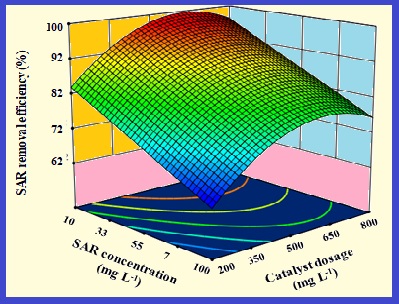Catalytic ozonation process using modified activated carbon as a cataly s t for the removal of sarafloxacin antibiotic from aqueous solutions
Volume 6, Issue 02, Pages 31-41, Jun 2023 *** Field: Analytical chemistry in nanobiotechnology
Abstract
Sarafloxacin (SAR) is an antibiotic from the fluoroquinolone group and is also one of the most widely used antibiotics in veterinary medicine. Potential performance and appropriate effectiveness have made SAR a special place among antibiotics. Antibiotic residues in the environment cause many problems, the most important of which is antibiotic resistance. Therefore, it is necessary to remove antibiotic residues from the environment. Response surface methodology (RSM) was utilized as a mathematics and statistics approach to optimize the removal efficiency of SAR using the catalytic ozonation process. The obtained regression equation for the response was the quadratic mathematical model. The coefficient of determination (R2), adjusted R2, and predicted R2 were obtained at 0.9939, 0.9917, and 0.9855, respectively. The maximum removal efficiency of 99.3% was obtained under optimum conditions, including a SAR concentration of 30.0 mg L-1, ozone dose of 1.5 mg min-1, catalyst dose (modified activated carbon) of 600 mg L-1, pH of 5.0, and reaction time of 30 min. According to the obtained results, the catalytic ozonation process as a suitable technique can efficiently remove SAR and other pharmaceutical compounds.
References
X. Weng, W. Cai, G. Owens, Z. Chen, Magnetic iron nanoparticles calcined from biosynthesis for fluoroquinolone antibiotic removal from wastewater, J. Clean. Prod., 319 (2021) 128734. https://doi.org/10.1016/j.jclepro.2021.128734
A. Samadi-Maybodi, M. Nikou, Removal of sarafloxacin from aqueous solution by a magnetized metal-organic framework; Artificial neural network modeling, Polyhedron J., 179 (2020) 114342. https://doi.org/10.1016/j.poly.2019.114342
Y. Ding, Z. Gao, H. Li, Real milk sample assisted selection of specific aptamer towards sarafloxacin and its application in the establishment of an effective aptasensor, Sens. Actuators B Chem., 343 (2021) 130113. https://doi.org/10.1016/j.snb.2021.130113.
W. Yan, Y. Xiao, W. Yan, R. Ding, S. Wang, F. Zhao, The effect of bioelectrochemical systems on antibiotics removal and antibiotic resistance genes: a review, Chem. Eng. J., 358 (2019) 1421-1437. https://doi.org/10.1016/j.cej.2018.10.128
X. Wang, R. Yin, L. Zeng, M. Zhu, A review of graphene-based nanomaterials for removal of antibiotics from aqueous environments, Environ. Pollut., 253 (2019) 100-110. https://doi.org/10.1016/j.envpol.2019.06.067
L. Wang, H. Jiang, H. Wang, P.L. Show, A. Ivanets, D. Luo, C. Wang, MXenes as heterogeneous fenton-like catalysts for removal of organic pollutants: A review, J. Environ. Chem. Eng., (2022) 108954. https://doi.org/10.1016/j.jece.2022.108954
T.-t. Zhu, Z.-x. Su, W.-x. Lai, Y.-b. Zhang, Y.-w. Liu, Insights into the fate and removal of antibiotics and antibiotic resistance genes using biological wastewater treatment technology, Sci. Total Environ., 776 (2021) 145906. https://doi.org/10.1016/j.scitotenv.2021.145906
S.A. Almodaresi, M. Mohammadrezaei, M. Dolatabadi, M.R. Nateghi, Qualitative analysis of groundwater quality indicators based on Schuler and Wilcox diagrams: IDW and Kriging models, J. Environ. Health Sustain. Dev, 4 (2019) 4. https://doi.org/10.18502/jehsd.v4i4.2023
M.J. Ahmed, S.K. Theydan, Fluoroquinolones antibiotics adsorption onto microporous activated carbon from lignocellulosic biomass by microwave pyrolysis, J. Taiwan Inst. Chem. Eng., 45 (2014) 219-226. https://doi.org/10.1016/j.jtice.2013.05.014
L. Wang, D. Luo, J. Yang, C. Wang, Metal-organic frameworks-derived catalysts for contaminant degradation in persulfate-based advanced oxidation processes, J. Clean. Prod., (2022) 134118. https://doi.org/10.1016/j.jclepro.2022.134118
F. Ghourchian, N. Motakef-Kazemi, E. Ghasemi, H. Ziyadi, Zn-based MOF-chitosan-Fe3O4 nanocomposite as an effective nano-catalyst for azo dye degradation, J. Environ. Chem. Eng., 9 (2021) 106388. https://doi.org/10.1016/j.jece.2021.106388
N.M. Kazemi, A novel sorbent based on metal–organic framework for mercury separation from human serum samples by ultrasound assisted-ionic liquid-solid phase microextraction, J. Environ. Anal., 2 (2019) 67-78. https://doi.org/10.24200/amecj.v2.i03.68
Z. He, X. Wang, Y. Luo, Y. Zhu, X. Lai, J. Shang, J. Chen, Q. Liao, Effects of suspended particulate matter from natural lakes in conjunction with coagulation to tetracycline removal from water, Chemosphere, 277 (2021) 130327. https://doi.org/10.1016/j.chemosphere.2021.130327
S. Ata, M. Feroz, I. Bibi, I.-u. Mohsin, N. Alwadai, M. Iqbal, Investigation of electrochemical reduction and monitoring of p-nitrophenol on imprinted polymer modified electrode, Synth. Met., 287 (2022) 117083. https://doi.org/10.1016/j.synthmet.2022.117083
D.G. Kim, D. Choi, S. Cheon, S.-O. Ko, S. Kang, S. Oh, Addition of biochar into activated sludge improves removal of antibiotic ciprofloxacin, J. Water Process. Eng., 33 (2020) 101019. https://doi.org/10.1016/j.jwpe.2019.101019
S. Sun, H. Yao, W. Fu, S. Xue, W. Zhang, Enhanced degradation of antibiotics by photo-fenton reactive membrane filtration, J. Hazard. Mater., 386 (2020) 121955. https://doi.org/10.1016/j.jhazmat.2019.121955
F. Haftan, N. Motakef-Kazemi, The sorbent based on MOF-5 and its polyurethane nanocomposite for copper adsorption from aqueous solution, J. Nanomed. Res., 6 (2021) 287-295. https://doi.org/10.22034/NMRJ.2021.03.009
A. Kausar, K. Naeem, M. Iqbal, Z.-i.-H. Nazli, H.N. Bhatti, A. Ashraf, A. Nazir, H.S. Kusuma, M.I. Khan, Kinetics, equilibrium and thermodynamics of dyes adsorption onto modified chitosan: a review, Z Phys. Chem., (2021) 000010151520191586. https://doi.org/10.1515/zpc-2019-1586
R. Anjali, S. Shanthakumar, Insights on the current status of occurrence and removal of antibiotics in wastewater by advanced oxidation processes, J. Environ. Manage., 246 (2019) 51-62. https://doi.org/10.1016/j.jenvman.2019.05.090
Z. Kang, X. Jia, Y. Zhang, X. Kang, M. Ge, D. Liu, C. Wang, Z. He, A review on application of biochar in the removal of pharmaceutical pollutants through adsorption and persulfate-based AOPs, Sustainability, 14 (2022) 10128. https://doi.org/10.3390/su141610128
N. Motakef kazemi, Zinc based metal–organic framework for nickel adsorption in water and wastewater samples by ultrasound assisted-dispersive-micro solid phase extraction coupled to electrothermal atomic absorption spectrometry, J. Environ. Anal., 3 (2020) 5-16. https://doi.org/10.24200/amecj.v3.i04.123
J. Gu, J. Xie, S. Li, G. Song, M. Zhou, Highly efficient electro-peroxone enhanced by oxygen-doped carbon nanotubes with triple role of in-situ H2O2 generation, activation and catalytic ozonation, Chem. Eng. J., 452 (2023) 139597. https://doi.org/10.1016/j.cej.2022.139597
N. Dabuth, S. Thuangchon, T. Prasert, V. Yuthawong, P. Phungsai, Effects of catalytic ozonation catalyzed by TiO2 activated carbon and biochar on dissolved organic matter removal and disinfection by-product formations investigated by Orbitrap mass spectrometry, J. Environ. Chem. Eng., 10 (2022) 107215. https://doi.org/10.1016/j.jece.2022.107215
H. Pokkiladathu, S. Farissi, A. Muthukumar, M. Muthuchamy, A novel activated carbon-based nanocomposite for the removal of bisphenol-A from water via catalytic ozonation: Efficacy and mechanisms, Results Chem., 4 (2022) 100593. https://doi.org/10.1016/j.rechem.2022.100593
H.N. Bhatti, Y. Safa, S.M. Yakout, O.H. Shair, M. Iqbal, A. Nazir, Efficient removal of dyes using carboxymethyl cellulose/alginate/polyvinyl alcohol/rice husk composite: adsorption/desorption, kinetics and recycling studies, Int. J. Biol. Macromol., 150 (2020) 861-870. https://doi.org/10.1016/j.ijbiomac.2020.02.093
A. Bukhari, M. Atta, A. Nazir, M.R. Shahab, Q. Kanwal, M. Iqbal, H. Albalawi, N. Alwadai, Catalytic degradation of MO and MB dyes under solar and UV light irradiation using ZnO fabricated using Syzygium Cumini leaf extract, Z Phys. Chem., 236 (2022) 659-671. https://doi.org/10.1515/zpch-2021-3096
M. Dolatabadi, H. Naidu, S. Ahmadzadeh, A green approach to remove acetamiprid insecticide using pistachio shell-based modified activated carbon; economical groundwater treatment, J. Clean. Prod., 316 (2021) 128226. https://doi.org/10.1016/j.jclepro.2021.128226
R.A. Khera, M. Iqbal, A. Ahmad, S.M. Hassan, A. Nazir, A. Kausar, H.S. Kusuma, J. Niasr, N. Masood, U. Younas, Kinetics and equilibrium studies of copper, zinc, and nickel ions adsorptive removal on to Archontophoenix alexandrae: conditions optimization by RSM, Desalin. Water Treat., 201 (2020) 289-300. https://doi: 10.5004/dwt.2020.25937
R. Huang, J. Yang, Y. Cao, D.D. Dionysiou, C. Wang, Peroxymonosulfate catalytic degradation of persistent organic pollutants by engineered catalyst of self-doped iron/carbon nanocomposite derived from waste toner powder, Sep. Purif. Technol., 291 (2022) 120963. https://doi.org/10.1016/j.seppur.2022.120963
U.H. Siddiqua, S. Ali, T. Hussain, M. Iqbal, N. Masood, A. Nazir, Application of multifunctional reactive dyes on the cotton fabric and conditions optimization by response surface methodology, J. Nat. Fibers, 19 (2022) 1094-1106. https://doi.org/10.1080/15440478.2020.1789532
M. Yoosefian, E. Rahmanifar, N. Etminan, Nanocarrier for levodopa Parkinson therapeutic drug; comprehensive benserazide analysis, Artif. Cells Nanomed. Biotechnol., 46 (2018) 434-446. https://doi.org/10.1080/21691401.2018.1430583
H. Raissi, A. Khanmohammadi, M. Yoosefian, F. Mollania, Ab initio and DFT studies on 1-(thionitrosomethylene) hydrazine: conformers, energies, and intramolecular hydrogen-bond strength, Struct. Chem., 24 (2013) 1121-1133. https://doi.org/10.1007/s11224-012-0144-6.
M.S. Thakur, N. Singh, A. Sharma, R. Rana, A.A. Syukor, M. Naushad, S. Kumar, M. Kumar, L. Singh, Metal coordinated macrocyclic complexes in different chemical transformations, Coord. Chem. Rev., 471 (2022) 214739. https://doi.org/10.1016/j.ccr.2022.214739
M. Chandel, M. Thakur, A. Sharma, D. Pathania, A. Kumar, L. Singh, Chlorophyll sensitized (BiO) 2CO3/CdWO4/rGO nano-hybrid assembly for solar assisted photo-degradation of chlorzoxazone, Chemosphere, 305 (2022) 135472. https://doi.org/10.1016/j.chemosphere.2022.135472
C. Mansas, J. Mendret, S. Brosillon, A. Ayral, Coupling catalytic ozonation and membrane separation: A review, Sep. Purif. Technol., 236 (2020) 116221. https://doi.org/10.1016/j.seppur.2019.116221
Y. Guo, J. Long, J. Huang, G. Yu, Y. Wang, Can the commonly used quenching method really evaluate the role of reactive oxygen species in pollutant abatement during catalytic ozonation, Water Res., 215 (2022) 118275. https://doi.org/10.1016/j.watres.2022.118275
Z. Mohamad, A.A. Razak, S. Krishnan, L. Singh, A. Zularisam, M. Nasrullah, Treatment of palm oil mill effluent using electrocoagulation powered by direct photovoltaic solar system, Chem. Eng. Res. Des., 177 (2022) 578-582. https://doi.org/10.1016/j.cherd.2021.11.019
G. Yu, Y. Wang, H. Cao, H. Zhao, Y. Xie, Reactive oxygen species and catalytic active sites in heterogeneous catalytic ozonation for water purification, Environ. Sci. Technol., 54 (2020) 5931-5946. https://doi.org/10.1021/acs.est.0c00575
E. Issaka, J.N.-O. Amu-Darko, S. Yakubu, F.O. Fapohunda, N. Ali, M. Bilal, Advanced catalytic ozonation for degradation of pharmaceutical pollutants―A review, Chemosphere, 289 (2022) 133208. https://doi.org/10.1016/j.chemosphere.2021.133208

JOURNAL PUBLISHING AGREEMENT
PLEASE PROVIDE US THE FOLLOWING INFORMATION,
Article entitled:
Corresponding author:
To be published in the journal:
Your Status
I am the sole author of the manuscript
- I am an Iranian government employee.
- I am a European government employee
- I am a Asian government
- None of the above
I am one author signing on behalf of all co-authors of the manuscript
- I am an Iranian government employee.
- I am a European government employee
- I am a Asian government
- None of the above
Please tick the above blanks (as appropriate), review the Journal Publishing Agreement, and then sign and date the document in black ink.
Published Journal Article: the author may share a link to the formal publication through the relevant DOI. Additionally theses and dissertations which contain embedded Published Journal Articles as part of the formal submission may be hosted publicly by the awarding institution with a link to the formal publication through the relevant DOI. Any other sharing of Published Journal Articles is by agreement with the publisher only.
Signed: ______________________________________ Name printed: ___________________________________________
Title and Company (if employer representative): _______________________Date: __________________________________














